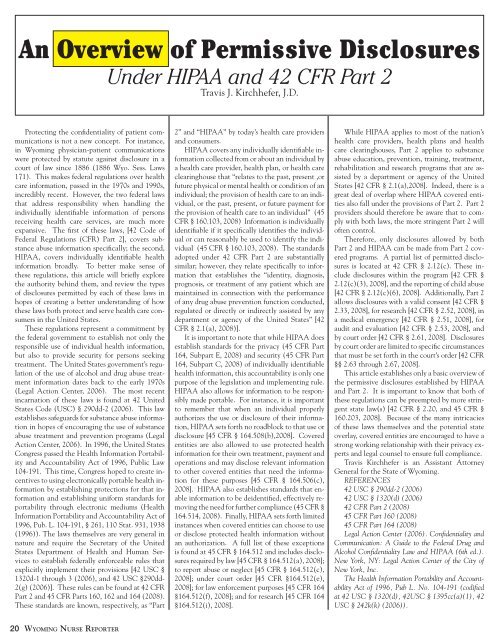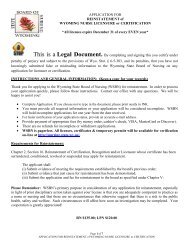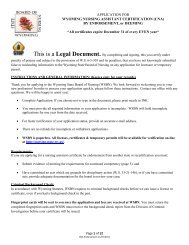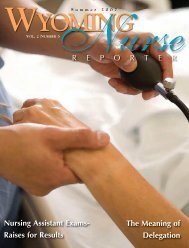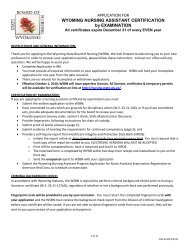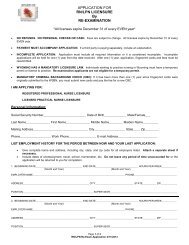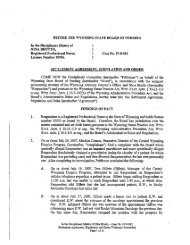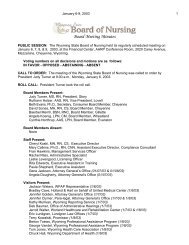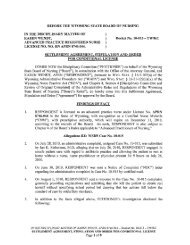Nurse Reporter Spring 2009 - Wyoming State Board of Nursing
Nurse Reporter Spring 2009 - Wyoming State Board of Nursing
Nurse Reporter Spring 2009 - Wyoming State Board of Nursing
Create successful ePaper yourself
Turn your PDF publications into a flip-book with our unique Google optimized e-Paper software.
An Overview <strong>of</strong> Permissive Disclosures<br />
Under HIPAA and 42 CFR Part 2<br />
Travis J. Kirchhefer, J.D.<br />
Protecting the confidentiality <strong>of</strong> patient communications<br />
is not a new concept. For instance,<br />
in <strong>Wyoming</strong> physician-patient communications<br />
were protected by statute against disclosure in a<br />
court <strong>of</strong> law since 1886 (1886 Wyo. Sess. Laws<br />
171). This makes federal regulations over health<br />
care information, passed in the 1970s and 1990s,<br />
incredibly recent. However, the two federal laws<br />
that address responsibility when handling the<br />
individually identifiable information <strong>of</strong> persons<br />
receiving health care services, are much more<br />
expansive. The first <strong>of</strong> these laws, [42 Code <strong>of</strong><br />
Federal Regulations (CFR) Part 2], covers substance<br />
abuse information specifically; the second,<br />
HIPAA, covers individually identifiable health<br />
information broadly. To better make sense <strong>of</strong><br />
these regulations, this article will briefly explore<br />
the authority behind them, and review the types<br />
<strong>of</strong> disclosures permitted by each <strong>of</strong> these laws in<br />
hopes <strong>of</strong> creating a better understanding <strong>of</strong> how<br />
these laws both protect and serve health care consumers<br />
in the United <strong>State</strong>s.<br />
These regulations represent a commitment by<br />
the federal government to establish not only the<br />
responsible use <strong>of</strong> individual health information,<br />
but also to provide security for persons seeking<br />
treatment. The United <strong>State</strong>s government’s regulation<br />
<strong>of</strong> the use <strong>of</strong> alcohol and drug abuse treatment<br />
information dates back to the early 1970s<br />
(Legal Action Center, 2006). The most recent<br />
incarnation <strong>of</strong> these laws is found at 42 United<br />
<strong>State</strong>s Code (USC) § 290dd-2 (2006). This law<br />
establishes safeguards for substance abuse information<br />
in hopes <strong>of</strong> encouraging the use <strong>of</strong> substance<br />
abuse treatment and prevention programs (Legal<br />
Action Center, 2006). In 1996, the United <strong>State</strong>s<br />
Congress passed the Health Information Portability<br />
and Accountability Act <strong>of</strong> 1996, Public Law<br />
104-191. This time, Congress hoped to create incentives<br />
to using electronically portable health information<br />
by establishing protections for that information<br />
and establishing uniform standards for<br />
portability through electronic mediums (Health<br />
Information Portability and Accountability Act <strong>of</strong><br />
1996, Pub. L. 104-191, § 261, 110 Stat. 931, 1938<br />
(1996)). The laws themselves are very general in<br />
nature and require the Secretary <strong>of</strong> the United<br />
<strong>State</strong>s Department <strong>of</strong> Health and Human Services<br />
to establish federally enforceable rules that<br />
explicitly implement their provisions [42 USC §<br />
1320d-1 through 3 (2006), and 42 USC §290dd-<br />
2(g) (2006)]. These rules can be found at 42 CFR<br />
Part 2 and 45 CFR Parts 160, 162 and 164 (2008).<br />
These standards are known, respectively, as “Part<br />
2” and “HIPAA” by today’s health care providers<br />
and consumers.<br />
HIPAA covers any individually identifiable information<br />
collected from or about an individual by<br />
a health care provider, health plan, or health care<br />
clearinghouse that “relates to the past, present ,or<br />
future physical or mental health or condition <strong>of</strong> an<br />
individual; the provision <strong>of</strong> health care to an individual,<br />
or the past, present, or future payment for<br />
the provision <strong>of</strong> health care to an individual” (45<br />
CFR § 160.103, 2008) Information is individually<br />
identifiable if it specifically identifies the individual<br />
or can reasonably be used to identify the individual<br />
(45 CFR § 160.103, 2008). The standards<br />
adopted under 42 CFR Part 2 are substantially<br />
similar; however, they relate specifically to information<br />
that establishes the “identity, diagnosis,<br />
prognosis, or treatment <strong>of</strong> any patient which are<br />
maintained in connection with the performance<br />
<strong>of</strong> any drug abuse prevention function conducted,<br />
regulated or directly or indirectly assisted by any<br />
department or agency <strong>of</strong> the United <strong>State</strong>s” [42<br />
CFR § 2.1(a), 2008)].<br />
It is important to note that while HIPAA does<br />
establish standards for the privacy (45 CFR Part<br />
164, Subpart E, 2008) and security (45 CFR Part<br />
164, Subpart C, 2008) <strong>of</strong> individually identifiable<br />
health information, this accountability is only one<br />
purpose <strong>of</strong> the legislation and implementing rule.<br />
HIPAA also allows for information to be responsibly<br />
made portable. For instance, it is important<br />
to remember that when an individual properly<br />
authorizes the use or disclosure <strong>of</strong> their information,<br />
HIPAA sets forth no roadblock to that use or<br />
disclosure [45 CFR § 164.508(b),2008]. Covered<br />
entities are also allowed to use protected health<br />
information for their own treatment, payment and<br />
operations and may disclose relevant information<br />
to other covered entities that need the information<br />
for these purposes [45 CFR § 164.506(c),<br />
2008]. HIPAA also establishes standards that enable<br />
information to be deidentified, effectively removing<br />
the need for further compliance (45 CFR §<br />
164.514, 2008). Finally, HIPAA sets forth limited<br />
instances when covered entities can choose to use<br />
or disclose protected health information without<br />
an authorization. A full list <strong>of</strong> these exceptions<br />
is found at 45 CFR § 164.512 and includes disclosures<br />
required by law [45 CFR § 164.512(a), 2008];<br />
to report abuse or neglect [45 CFR § 164.512(c),<br />
2008]; under court order [45 CFR §164.512(e),<br />
2008]; for law enforcement purposes [45 CFR 164<br />
§164.512(f), 2008]; and for research [45 CFR 164<br />
§164.512(i), 2008].<br />
While HIPAA applies to most <strong>of</strong> the nation’s<br />
health care providers, health plans and health<br />
care clearinghouses, Part 2 applies to substance<br />
abuse education, prevention, training, treatment,<br />
rehabilitation and research programs that are assisted<br />
by a department or agency <strong>of</strong> the United<br />
<strong>State</strong>s [42 CFR § 2.1(a),2008]. Indeed, there is a<br />
great deal <strong>of</strong> overlap where HIPAA covered entities<br />
also fall under the provisions <strong>of</strong> Part 2. Part 2<br />
providers should therefore be aware that to comply<br />
with both laws, the more stringent Part 2 will<br />
<strong>of</strong>ten control.<br />
Therefore, only disclosures allowed by both<br />
Part 2 and HIPAA can be made from Part 2 covered<br />
programs. A partial list <strong>of</strong> permitted disclosures<br />
is located at 42 CFR § 2.12(c). These include<br />
disclosures within the program [42 CFR §<br />
2.12(c)(3), 2008], and the reporting <strong>of</strong> child abuse<br />
[42 CFR § 2.12(c)(6), 2008]. Additionally, Part 2<br />
allows disclosures with a valid consent [42 CFR §<br />
2.33, 2008], for research [42 CFR § 2.52, 2008], in<br />
a medical emergency [42 CFR § 2.51, 2008], for<br />
audit and evaluation [42 CFR § 2.53, 2008], and<br />
by court order [42 CFR § 2.61, 2008]. Disclosures<br />
by court order are limited to specific circumstances<br />
that must be set forth in the court’s order [42 CFR<br />
§§ 2.63 through 2.67, 2008].<br />
This article establishes only a basic overview <strong>of</strong><br />
the permissive disclosures established by HIPAA<br />
and Part 2. It is important to know that both <strong>of</strong><br />
these regulations can be preempted by more stringent<br />
state law(s) [42 CFR § 2.20, and 45 CFR §<br />
160.203, 2008]. Because <strong>of</strong> the many intricacies<br />
<strong>of</strong> these laws themselves and the potential state<br />
overlay, covered entities are encouraged to have a<br />
strong working relationship with their privacy experts<br />
and legal counsel to ensure full compliance.<br />
Travis Kirchhefer is an Assistant Attorney<br />
General for the <strong>State</strong> <strong>of</strong> <strong>Wyoming</strong>.<br />
REFERENCES<br />
42 USC § 290dd-2 (2006)<br />
42 USC § 1320(d) (2006)<br />
42 CFR Part 2 (2008)<br />
45 CFR Part 160 (2008)<br />
45 CFR Part 164 (2008)<br />
Legal Action Center (2006). Confidentiality and<br />
Communication: A Guide to the Federal Drug and<br />
Alcohol Confidentiality Law and HIPAA (6th ed.).<br />
New York, NY: Legal Action Center <strong>of</strong> the City <strong>of</strong><br />
New York, Inc.<br />
The Health Information Portability and Accountability<br />
Act <strong>of</strong> 1996, Pub L. No. 104-191 (codified<br />
at 42 USC § 1320(d), 42USC § 1395cc(a)(1), 42<br />
USC § 242k(k) (2006)).<br />
20 Wy o m i n g Nu r s e Re p o r t e r


